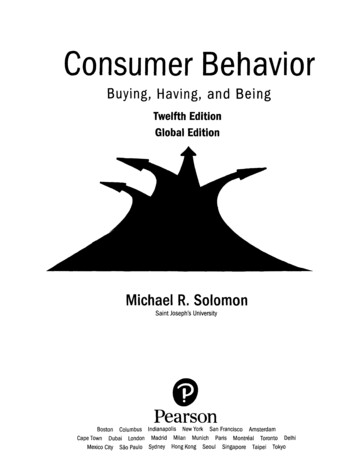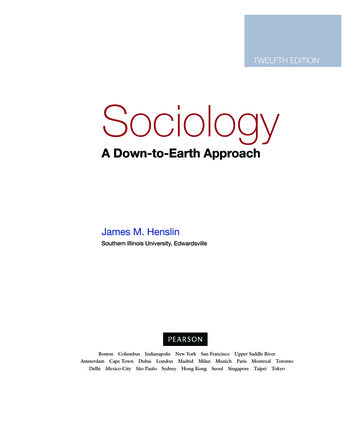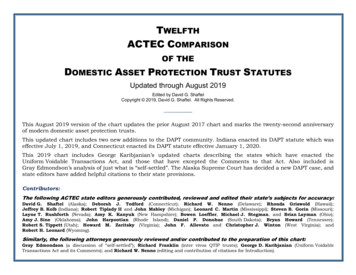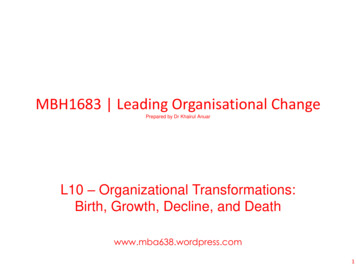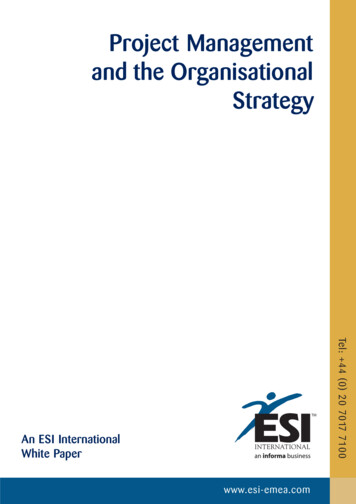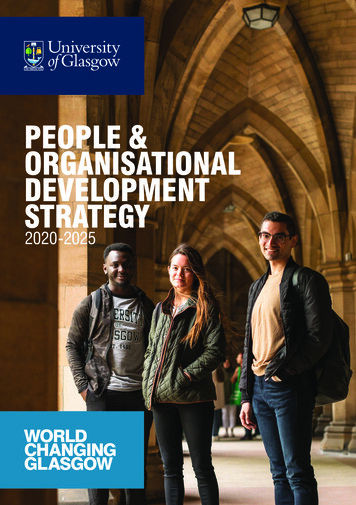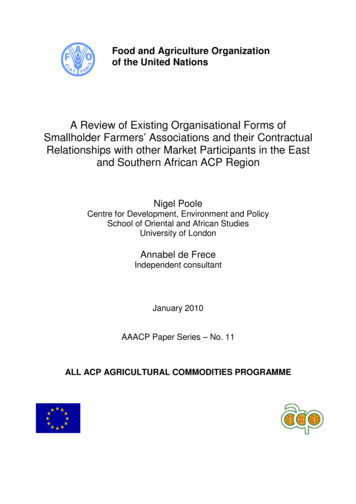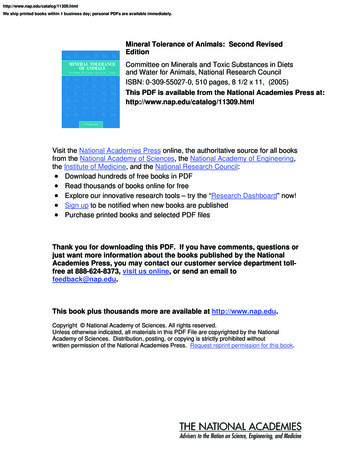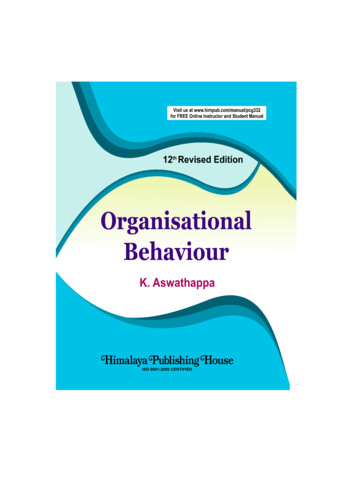
Transcription
Twelfth Revised Edition 2016Organisational BehaviourK. Aswathappa, Ph.D.Former Director,Canara Bank School of Management Studies,Bangalore University,Bangalore.MUMBAI NEW DELHI NAGPUR BENGALURU HYDERABAD CHENNAI PUNE LUCKNOW AHMEDABAD ERNAKULAM BHUBANESWAR INDORE KOLKATA GUWAHATI
AuthorNo part of this publication may be reproduced, stored in a retrieval system, or transmitted in any form or by any means,electronic, mechanical, photocopying, recording and/or otherwise without the prior written permission of the publisher.First Edition:1991Sixth Revised and Enlarged Edition:2005Second Revised Edition:1994Seventh Edition:2007Third Revised Edition:1996Eighth Revised and Enlarged Edition:2009Fourth Revised Edition:1997Ninth Revised and Enlarged Edition:2010Reprint February, July:1998Tenth Revised and Enlarged Edition:2012Reprint:1999Eleventh Revised Edition:2013Fifth Revised Edition:2000Edition:2014, 2015Reprint:2001, 2002, 2003, 2004Twelfth Revised Edition:2016Published by: Mrs. Meena Pandey for Himalaya Publishing House Pvt. Ltd.,“Ramdoot”, Dr. Bhalerao Marg, Girgaon, Mumbai - 400 004.Phone: 022-23860170/23863863, Fax: 022-23877178E-mail: himpub@vsnl.com; Website: www.himpub.comBranch Offices:New Delhi: “Pooja Apartments”, 4-B, Murari Lal Street, Ansari Road, Darya Ganj,New Delhi - 110 002. Phone: 011-23270392, 23278631; Fax: 011-23256286Nagpur: Kundanlal Chandak Industrial Estate, Ghat Road, Nagpur - 440 018.Phone: 0712-2738731, 3296733; Telefax: 0712-2721216Bengaluru: No. 16/1 (Old 12/1), 1st Floor, Next to Hotel Highlands, Madhava Nagar,Race Course Road, Bengaluru - 560 001.Phone: 080-22286611, 22385461, 4113 8821, 22281541Hyderabad: No. 3-4-184, Lingampally, Besides Raghavendra Swamy Matham, Kachiguda,Hyderabad - 500 027. Phone: 040-27560041, 27550139Chennai: New-20, Old-59, Thirumalai Pillai Road, T. Nagar, Chennai - 600 017. Mobile: 9380460419Pune: First Floor, "Laksha" Apartment, No. 527, Mehunpura, Shaniwarpeth(Near Prabhat Theatre), Pune - 411 030. Phone: 020-24496323/24496333;Mobile: 09370579333Lucknow: House No 731, Shekhupura Colony, Near B.D. Convent School, Aliganj,Lucknow - 226 022. Phone: 0522-4012353; Mobile: 09307501549Ahmedabad: 114, “SHAIL”, 1st Floor, Opp. Madhu Sudan House, C.G. Road, Navrang Pura,Ahmedabad - 380 009. Phone: 079-26560126; Mobile: 09377088847Ernakulam: 39/176 (New No: 60/251) 1st Floor, Karikkamuri Road, Ernakulam,Kochi – 682011. Phone: 0484-2378012, 2378016 Mobile: 09387122121Bhubaneswar: 5 Station Square, Bhubaneswar - 751 001 (Odisha).Phone: 0674-2532129, Mobile: 09338746007Indore: Kesardeep Avenue Extension, 73, Narayan Bagh, Flat No. 302, IIIrd Floor,Near Humpty Dumpty School, Indore - 452 007 (M.P.). Mobile: 09303399304Kolkata: 108/4, Beliaghata Main Road, Near ID Hospital, Opp. SBI Bank,Kolkata - 700 010, Phone: 033-32449649, Mobile: 7439040301Guwahati: House No. 15, Behind Pragjyotish College, Near Sharma Printing Press,P.O. Bharalumukh, Guwahati - 781009, (Assam).Mobile: 09883055590, 08486355289, 7439040301DTP by: Priyanka M.Printed at: Geetanjali Press Pvt. Ltd., Nagpur. On behalf of HPH
Preface to the Twelfth Revised EditionOrganisational Behaviour is coming out in its Twelfth edition. But not before incorporating several changes onthe following lines:AdditionsChapter 1: New and updated table on the best companies to work for; Additional inputs to the text.Chapter 2: Additional inputs to the text.Chapter 3: Three new challenges to OB: Career management, Talent management and Globalisation. Newclosing case.Chapter 4: New chapter on Ethics and Social Responsibility.Chapter 5: MARS model of behaviour is added; New exercises included.Chapter 6: New opening case; New section on types of intelligence; Additional inputs to the text.Chapter 7: New opening case; New closing case; Text recast.Chapter 8: New opening case; Additional inputs to the text.Chapter 10: New opening case; Social Information Processing Model added; Responses to job dissatisfaction rewritten.Chapter 11: New section on Motivation across Cultures added.Chapter 12: New section on Employee Engagement.Chapter 13: Additional inputs to the text.Chapter 15: New exhibit.Chapter 17: Chapter renamed; New sections added on Psychological Contract, Trust and Deviance.Chapter 18: New EDP techniques such as Coaching, Action learning, Staff meetings, Lateral transfers, Seminarsand conferences, Case studies and Corporate universities; New section on Leadership across cultures.Chapter 19: Additional inputs on Channel; E-mail; Choosing a channel; TA for Effective communication.Chapter 21: New write-up on leader’s embedding values on organisational culture.Chapter 22: New section on Reasons why change fails to produce change; New exercise.OthersA new feature is unique to the present edition: Key Terms. Key terms with definitions are appended to eachchapter. Definitions are catchy and close to the real-life happenings.Learning objectives for all the chapters have been rewritten. In each chapter, connectivity among learning objectives,text and summary has been maintained by indicating numbers of objectives in the text and summary. Likewise, keyterms are page-numbered.May I submit that the Twelfth edition of Organisational Behaviour is much enriched. It is upto the esteemedreaders to comment on it.— K. Aswathappadr k aswathappa@yahoo.com
Preface to the First EditionOrganisational behaviour is a fascinating subject. The more one reads about it the more absorbingdoes it become. From practical application point of view also, probably the subject “OrganisationalBehaviour” ranks first among other management-oriented disciplines. It is for these reasons that the subjectis recommended as one of the disciplines of study for M.Com., MBA and various diploma courses inmanagement.Unfortunately, not many books are written by Indian authors on organisational behaviour. A readeris, therefore, forced to depend upon books authored by foreign writers. Though the foreign books are ofhigh standard, they only reflect the cultural ethos of the countries in which they are written and published.What is needed for an Indian student is a book which can help blend principles of organisational behaviourwith the cultural moorings of our people.Organisational Behaviour is a small attempt in this direction. As can be seen in the subsequent pagesof this book, anecdotes drawn from our own cultural milieu have been used to explain the principles oforganisational behaviour more tellingly.Organisational Behaviour is divided into four parts. Part-I introduces the subject, Part-II coversdiscussion on individual behaviour, Part-III focuses on inter-individual behaviour, and Part-IV includesdiscussion on organisations. The arrangement of chapters is logical. Figures have been used extensivelyto reduce monotony of reading. Further, instead of simply explaining a concept and leaving it at that, wehave tried to bring out the managerial implications of each principle. We hope that the book will behighly useful to the readers.In preparation of the text, we have consulted several sources which have been acknowledged atrelevant contexts. We wish to place on record our grateful thanks to Prof. O.R. Krishnaswami, formerDean, Department of Commerce and Management, Bangalore University, for his encouragement andadvice which were of immense help to us.We thanks Shri. D.P. Pandey of Himalaya Publishing House Pvt. Ltd. for bringing out this book.— K. Aswathappa
ContentsChapter 1A Prelude to Organisational Behaviour1 – 31Learning Objectives – Opening Case – What are Organisations? – Why doOrganisations Exist? – Nature of Organisational Behaviour – Foundations of OB– Why Study OB? – Shortcomings – Organisational Arrangement for OB –Contemporary OB – Scope of Organisational Behaviour – Contextual Perspectivesof OB – Evolution of OB – OB Model – Summary – Key Terms – Questions –Exercises – Closing Cases I and II – References.Chapter 2Management and Managers32 – 56Learning Objectives – Opening Case – Nature of Management – Functions ofManagement – Manager’s Roles – Types of Managers – Changing Hierarchies ofManagers – What Makes Managers Successful? – Evolution of Management Theory– Indian Contributions to Management Practices – Contemporary Trends inManagement Thinking – Summary – Key Terms – Questions – Exercise – ClosingCase – References.Chapter 3OB — The Emerging Challenges57 – 88Learning Objectives – Opening Case – Managing Diversity – Career Management– Talent Management – Changing Demographics of Workforce – ChangedEmployee Expectations – Globalisation – Technology Transformation – PromotingEthical Behaviour and CSR – Organisational Justice – Summary – Key Terms –Questions – Exercises – Closing Case – References.Chapter 4Ethics and Social Responsibility89 – 109Learning Objectives – Ethics – Sources of Business Ethics – Social Responsibility,CSR Debate, Common Characteristics – Summary – Key Terms – Questions –Exercise – Closing Case.Chapter 5Foundations of Individual Behaviour110 – 130Learning Objectives – Opening Case – Personal Factors – Environmental Factors– Organisational Systems and Resources – Models of Individual Behaviour –Summary – Key Terms – Questions – Exercises – Closing Case – References.Chapter 6Intelligence131 – 143Learning Objectives – Opening Case – Nature of Intelligence – Types of Intelligence– Theories of Intelligence – Measurement of Intelligence – Factors InfluencingIntelligence – Intelligence and OB – Summary – Key Terms – Questions – TeachYourself – Closing Case – References.Chapter 7PersonalityLearning Objectives – Opening Case – Nature of Personality – The Shaping ofPersonality – Determinants of Personality – Personality Structure – OB RelatedTraits – Personality and OB – Summary – Key Terms – Questions – Exercises –Closing Case – References.144 – 168
Chapter 8Perception and Attribution169 – 199Learning Objectives – Opening Case – Perception: Meaning and Definition –Factors Influencing Perception – Perceptual Process – The Process of Interpreting– Attribution Theory – When Perception Fails – Perception and OB – Managingthe Perception Process – Social Perception – Summary – Key Terms – Questions– Exercises – Closing Case – References.Chapter 9Learning200 – 223Learning Objectives – Opening Case – Meaning and Definition – Learning —Explicit and Tacit Knowledge – How Learning Occurs? – Principles of Learning –Learning and OB – Conclusion – Summary – Key Terms – Questions – Exercise –Closing Case – References.Chapter 10Attitudes and Values224 – 255Learning Objectives – Opening Case – Nature of Attitudes – Components ofAttitudes – Formation of Attitudes – Functions of Attitudes – Changing Attitudes –Work-related Attitudes – Values – Attitudes, Values and OB – Summary – KeyTerms – Questions – Exercises – Closing Case – References.Chapter 11Motivation — Theories and Principles256 – 301Learning Objectives – Opening Case – Nature of Motivation – Importance ofMotivation – Motivational Challenges – Theories on Motivation – Review ofTheories – Motivation across Cultures – Summary – Key Terms – Questions –Exercises – Closing Case – References.Chapter 12Applied Motivational Practices302 – 338Learning Objectives – Opening Case – Rewards – Job Design – BehaviourModification – Empowerment – Goal Setting Theory – Problem Employees –Quality of Work Life – Employee Engagement – Others – Summary – Key Terms– Questions – Exercise – Closing Case – References.Chapter 13Work Stress339 – 362Learning Objectives – Opening Case – Meaning and Definition – The StressExperience – Work Stress Model – Burnout – Stress Management – Stress andPerformance – Summary – Key Terms – Questions – Exercises – Closing Case –References.Chapter 14Group Dynamics363 – 400Learning Objectives – Opening Case – Nature of Groups – Types of Groups –Why do People Join Groups? – Group Development – Usefulness of Groups inOrganisations – Pitfalls of Groups – Determinants of Group Behaviour – GroupStructuring – Group Decision Making – Groups and OB – Summary – Key Terms– Questions – Exercises – Closing Cases I and II – References.Chapter 15Team DynamicsLearning Objectives – Opening Case – Nature of Teams – Teams vs. Groups –Benefits from Teams – Types of Teams – Implementing Teams in Organisations –Team Issues – Effective Teamwork – Typical Teams in Organisations – Can GroupsBecome Teams? – Summary – Key Terms – Questions – Exercises – Closing Case– References.401 – 420
Chapter 16Power and Political Behaviour421 – 447Learning Objectives – Opening Case – Power – Politics – Ethics of Power andPolitics – Summary – Key Terms – Questions – Exercises – Closing Case– References.Chapter 17Workplace Behaviour – Conflict, Negotiation, Trust, PsychologicalContract and Deviance448 – 485Learning Objectives – Opening Case – Nature of Conflict – Changing Views ofConflict – Functional and Dysfunctional Conflict – The Process of Conflict – Levelsof Conflict – Conflict Resolution – Managerial Implications – Negotiation andConflict Resolution – Deviance – Psychological Contract – Trust – Summary –Key Terms – Questions – Exercise – Closing Case – References.Chapter 18Leadership — Influencing Others486 – 535Learning Objectives – Opening Case – Nature of Leadership – Leadership andManagement – Importance of Leadership – Formal and Informal Leadership –Leadership Styles and Their Implications – Theories of Leadership – What Does ItMean? – Contemporary Issues on Leadership – Summary – Key Terms – Questions– Exercise – Closing Case – References.Chapter 19Communication536 – 571Learning Objectives – Opening Case – Meaning and Definition – Significance –Interpersonal Communication – Organisational Communication – CommunicationNetworks – Communication Roles – Communication Policies and theCommunication Audit – Informal Communication – Communication Media –Information Technologies – Managerial Implications – Summary – Key Terms –Questions – Exercises – Closing Case – References.Chapter 20Organisations572 – 610Learning Objectives – Opening Case – Nature of Organisations – OrganisationalStructure – Organisational Design – Key Factors in Organisational Design – Typesof Organisational Structures – Organisations for Future – Structure Decisions –Informal Organisations – Managerial Implications – Summary – Key Terms –Questions – Exercises – Closing Case – References.Chapter 21Organisational Culture, Creativity and Innovation611 – 646Learning Objectives – Opening Case – Meaning and Definition – CulturalDimensions – How is Culture Created? – Sustaining the Culture – Effects of Culture– Changing Organisational Culture – Creativity in Organisations – Innovation inOrganisations – Summary – Key Terms – Questions – Exercises – Closing Case –References.Chapter 22Organisational Change and DevelopmentLearning Objectives – Opening Case – Nature of Change – Levels of Change –Importance of Change – Types of Change – Forces for Change in Organisations –Resistance to Change – The Change Process – Organisational Development –OD Interventions – Time to Implement Change – Managerial Implications –Summary – Key Terms – Questions – Closing Case – References.647 – 682
Chapter 23Decision Making683 – 701Learning Objectives – Opening Case – Nature of Decision and Decision Making– Types of Decisions – Decision Making Conditions – Models of Decision Making– Decision Making Process – Barriers to Effective Decision Making – DecisionMaking Styles – Individual vs. Group Decision Making – Summary – Key Terms –Questions — Exercise – Closing Case – References.Chapter 24Human Resource Policies and Practices702 – 719Learning Objectives – Human Resource Policies – Human Resource Planning –Job Analysis – Recruitment – Selection – Orientation and Placement – Trainingand Development – Employee Remuneration – Performance Appraisal – JobEvaluation – Industrial Relations – Summary – Key Terms – Questions – ClosingCase I and II – References.Chapter 25International Organisational Behaviour720 – 752Learning Objectives – Opening Case – Trends in International Business – CulturalDifferences and Similarities – Individual Behaviour in the Global Perspective –Interpersonal Behaviour across Cultures – Organisational Characteristics in anInternational Context – Summary – Key Terms – Questions – Exercise – ClosingCase – References.Index753 – 760
1A PRELUDE TOORGANISATIONALBEHAVIOUR“I am not smart. I try to observe. Millions saw the apple fall, but Newton was the one who asked why.”— B. Baruch“Wise men talk because they have something to say; fools, because they have to say something.”— PlatoAfter reading this chapter, you should understand —1. Nature of organisations, reasons why they exist and theireffectiveness2. Nature of OB3. Foundations for OB4. Reasons why one should study OB5. Shortcomings of OB6. Behavioural sciences that have contributed to OB7. Scope of OB8. Approaches to the study of OB9. Evolution of OB10. Model that helps study of OB in a systematic way.
2Organisational Behaviour Chapter One . Opening CaseA Tale of Twists and TurnsRudely shaken, Vijay came home in the evening. He was not in a mood to talk to his wife.Bolted inside, he sat in his room, lit a cigarette, and brooded over his experience with acompany he loved most.Vijay, an M.Com. and an ICWA, joined the finance department of a Bangalore-based electriccompany (Unit 1), which boasts of an annual turnover of 400 crore. He is smart, intelligent, butconscientious. He introduced several new systems in record-keeping and was responsible for costreduction in several areas. Being a loner, Vijay developed few friends in and outside the organisation.He also missed promotions four times though he richly deserved them.G.M. Finance saw to it that Vijay was shifted to Unit 2 where he was posted in the purchasedepartment, though purchase was not his cup of tea. Vijay went into it whole hog, streamlined thepurchasing function and introduced new systems, particularly in vendor development. Being honesthimself, Vijay ensured that nobody else made money through questionable means.After two years in purchase department, Vijay was shifted to stores. From finance to purchaseand then to stores was too much for Vijay to swallow.He burst out before the unit head, 2 and unable to control his anger, Vijay put in his papers too.The unit head was aghast at this development but did nothing to console Vijay. He forwarded thepapers to the V.P. Finance, Unit 1.The V.P. Finance called in Vijay, heard him for a couple of hours, advised him not to lose heart,assured him that his interests would be taken care of, and requested him to resume duties in purchasedepartment of Unit 2: Vijay was also assured that no action would be taken on the papers he had putin.Six months passed by. Then came the time to effect promotions. The list of promotees wasannounced and to his dismay, Vijay found that his name was missing. Angered, Vijay met the unithead 1 who coolly told Vijay that he could collect his dues and pack off to his house for good. It wasgreat betrayal for Vijay.We now take you to an exciting field of human behaviours in organisational settings. Suchbehaviours reveal varied and differing stories about individuals working in organisations. Someare inspiring and others are almost devastating (see opening case). Organisational Behaviour(OB) tells us the stories illustrating with the causes for actions, their consequences, and correctivemeasures if things go wrong. Before understanding the nature of OB, it is useful to gain knowledgeabout the organisations themselves.Few things touch our daily life as much as organisations do. We depend on organisationsfor education, employment, food, clothing, shelter, health, wealth, recreation, travel, and muchmore. They touch every aspect of human life, from birth-to-death. In fact, life becomes unlivablesans organisations.But most of us have a casual attitude towards organisations. We notice their importancewhen they fail to deliver their goods and services to us. For example, when trains stop running,we take notice of the indifferent services rendered by railways. When electricity fails, we blamethe State Electricity Board for its incompetent and corrupt administration. When doctors in aGovernment hospital strike work, we blame the Government, and so on. It is essential for us tounderstand what these organisations are, how do they function and how to make them moreeffective in their functioning. These and other related issues are addressed in this book.
Chapter One A Prelude to Organisational BehaviourWHAT ARE ORGANISATIONS? (LO1)Organisations are as old as the human race itself. Archaeologists have discovered massivetemples dating back to 3500 BC that were constructed through the organised actions of manypeople. The fact that these impressive monuments were built suggest that not only did complexorganisations exist, but that the people in them worked cohesively for common causes.We have equally impressive examples of contemporary organisations such as Hong Kong’snew island airport at Chek Lap Kok, the Hiberria Oil Platform off the East Coast, North America,and the complex network of computer connections — the Internet.What, then, are these powerful constructs that we call organisations? They are groups ofpeople who work independently towards some purpose. Organisations are not physicalstructures; rather, they are people who work together to achieve a set of shared goals. Peoplewho work in organisations have structured patterns of interactions, meaning that they expecteach other to complete certain tasks in an organised way.EXHIBIT 1.1: ANJI (NEYA) FROM TADEPALLIWho creates these organisations? Often an individual (See Exhibit 1.1) or a group of people,who believe that they possess the necessary skills and knowledge, form an organisation to producegoods and services. At times, several people form a group to respond to a perceived need bycreating an organisation. People with a lot of money may invest jointly to build a vacation resort.A group of people with similar beliefs may build a new place of worship or citizens of a State mayfloat a new political party.Anji is the short form of Anjineya, which in turn is the vernacular of the monkey godHanuman, in Ramayana, is reported to have brought cure to ailing Laxmana, the youngerbrother of Rama. Anji (read Anji Reddy) is also providing medicines to cure ailments of millionsof people today. In the bargain, his company, Reddy Laboratories Ltd., earned 132.2 bn insales (2013). His is the first pharmaceutical company from the Asia-Pacific region to be listedon the New York Stock Exchange and the Nasdaq. Dr. Reddy was chosen the Businessman ofthe Year 2001 by Business India. And all this in a short span of 15 years. Reddy has shown whatis possible to do in India even with all the hurdles and handicaps Indian businesses have toovercome.Reddy hails from Andhra Pradesh and spent his childhood in a small village across theKrishna River near Vijayawada, where his father was a prosperous farmer growing turmeric.His early education took place in the Hindu College and the Andhra Christian College, Guntur.After his B.Sc. in Guntur, Reddy joined the UDCT in Bombay to study pharmacy.He then went to the National Chemical Laboratory, Pune, to study for a doctoral degree.This is when he decided to switch his field from pharmacy to chemical engineering, in which helater prospered.He later joined the IDPL, the newly established bulk drug manufacturing unit in public sectorin Hyderabad. After a few years, he could not stand the non-entrepreneurial culture and quit toform a company with a little seed money, called Uniloyds. It made a successful foray intopharmaceuticals, but his partner wanted control though he had no idea about the business.Reddy quickly encashed his share and joined an old classmate C.R. Reddy to found StandardOrganics Ltd., (SOL). SOL, under Reddy’s leadership, soon became the largest producer ofsulfamethaxaole and even won an R&D award from the Indian Chemical Manufacturer’sAssociation. But his partner had other plans on diversification and Reddy came out of it toestablish Dr. Reddy’s Lab. and Cheminor for bulk drug manufacture in the mid-1980s.The early-1990s saw an upheaval in both Dr. Reddy’s Lab. and Cheminor. Key people left,the two units got merged, son and son-in-law were inducted, and the Reddy Laboratories wason the way to prove all the cassandras, who were saying that only big pharma companies withresearch budgets of billions of dollars could do drug discovery, dead wrong. 1Anji is well poised doing it and has emerged the Anjineya of modern days. (Sadly heexpired in 2013)3
4Organisational Behaviour Chapter OneIn general, entrepreneurship is the term used to describe the process by which peoplerecognize opportunities, garner resources and put them to use to produce goods and services.The rewards of entrepreneurship are as varied as the spiritual satisfaction derived by the believerswho build a place of worship, or the profit generated for the founders and shareholders of aresort that successfully responded to people’s recreational needs.WHY DO ORGANISATIONS EXIST?(LO1)In the beginning of this chapter, we stated that life is unlivable without organisations. Thisis a broad statement about the usefulness of organisations in any society. Specifically, organisationsplay five different roles (See Fig. 1.1), thus, reiterating their role. As seen from the figure, anorganisation allows people to jointly increase specialisations and division of labour, use largescale technology, manage the external environment, economise on transaction costs, and exertpower and control — all of which, increase the value the organisation can create.2Increasedspecialisation anddivision of labourUselarge-scaletechnologyOrganisationallows peoplejointly to:Manage theexternalenvironmentWhich increases thevalue that an organisationcan createEconomiseontransaction costsFigure 1.1:Five Reasons whyOrganisationExistExert powerandcontrolTo Increase Specialisation and Division of Labour: People who work in organisations maybecome more productive and efficient at what they do than people who work alone. For manykinds of productive work, the use of an organisation allows the development of specialisationand division of labour. The collective nature of organisation allows individuals to focus on anarrow area of expertise, which allows them to become more skilled or specialised at what theydo.3There are several firms, such as Wipro, TCS, Infosys, IBM, Apple and Facebook which haveprovided enabling environments for individuals to enhance their skills for organisation andindividual growth.To Use Large-scale Technology: Organisations are able to take advantage of the economiesof scale and scope that result from the use of modern automated computerised technology.Economies of scale are the cost savings that result when goods and services are produced inlarge volumes by automated production. Economies of scope are the cost savings that resultwhen an organisation is able to use underutilised resources more effectively because they canbe shared across several different products or tasks. Economies of scope (as well as of scale) can
Chapter One A Prelude to Organisational Behaviourbe achieved, for example, when it is possible to design an automated production line that canmake different types of products simultaneously.To Manage the External Environment: Pressures from the environment in which organisationsoperate necessitate organising productive resources. An organisation’s environment includesnot only economic, social and political factors but also the sources from which it obtains inputsand the marketplace into which it releases its outputs. Managing complex environments is atask beyond the abilities of most individuals, but an organisation has the resources to developspecialists to anticipate or attempt to influence the many demands from the environment. Thisspecialisation allows the organisation to create more value for itself, its members, and itscustomers.4To Economise on Transaction Costs: When people co-operate to produce goods and services,certain problems arise as they learn what to do and how to work with others to perform a taskeffectively. People have to jointly decide who will do which tasks (the division of labour), whowill get paid what amounts, and how to decide if each worker is doing his or her share of thework. The costs associated with negotiating, monitoring and governing exchanges betweenpeople are called transaction costs. Organisation’s ability to control the exchanges betweenpeople reduces the transaction costs associated with the exchanges.To Exert Power and Control: Organisations can exert great pressure on individuals to conformto task and production requirements in order to increase production efficiency. To get a jobdone efficiently, it is important for people to come to work in a predictable fashion, to behavein the interest of the organisation and to accept the authority of the organisation and its managers.All these requirements make production less costly and more efficient but put a burden onindividuals who must conform to these regulations. When individuals work for themselves,they need to address only their own needs. When they work for an organisation, however, theymust pay attention to the organisation’s needs as well as their own. Organisations can disciplineor fire workers who fail to conform and can reward good performance with promotion andincreased rewards. Because employment, promotion, and increased rewards are important andoften scarce, organisations can use them to exert power over individuals.Taken together, these five factors help explain why more value can often be created whenpeople work together, co-ordinating their actions in an organised setting, than when they workalone. Over time, the stability created by an organisation provides a setting in which theorganisation
Preface to the Twelfth Revised Edition Organisational Behaviour is coming out in its Twelfth edition. But not before incorporating several changes on the following lines: Additions Chapter 1: New and updated table on the b
